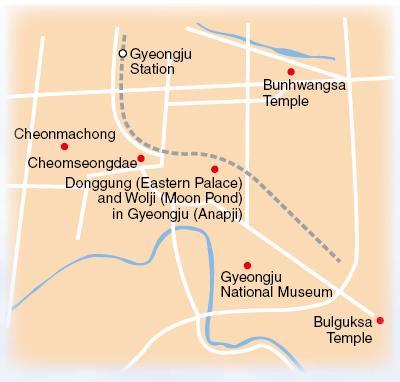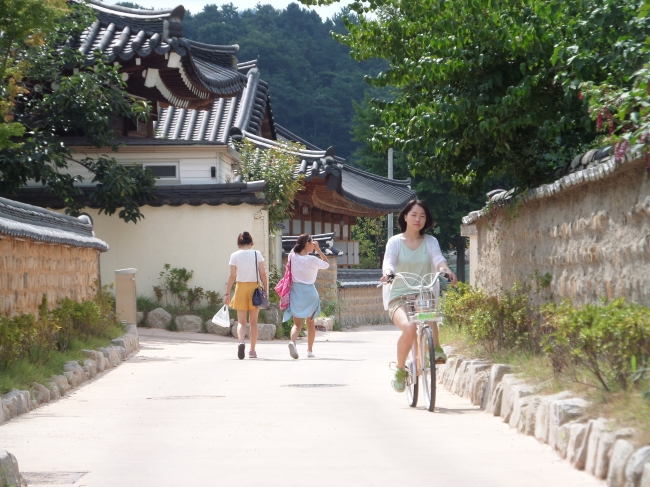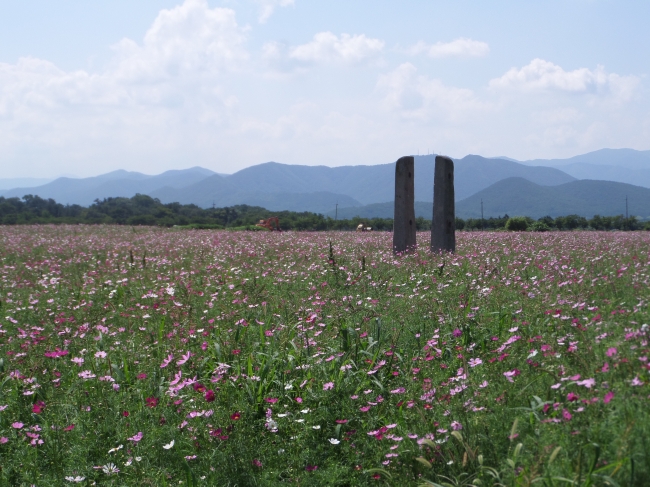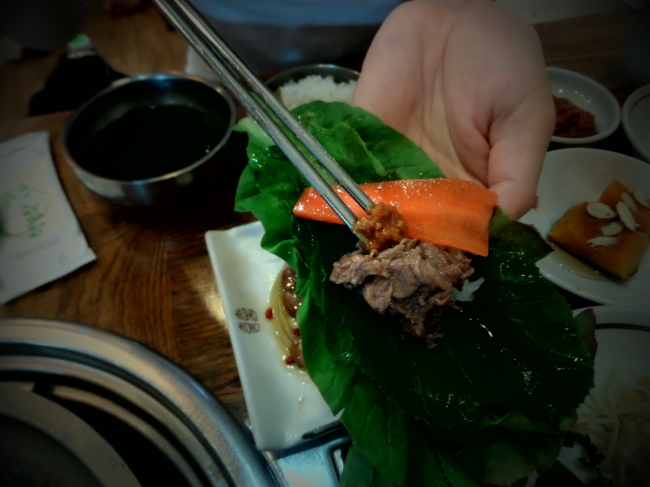This is the ninth installment in an 11-part series that introduces some of the best walking trails in Korea. Based on each trail’s popularity and the recommendations of travel experts and the Culture Ministry, The Korea Herald selected the 10 best places for walking and hiking. The series received funding from the Korea Press Foundation. ― Ed.
Home to some of the most exquisite ancient relics in the country, Gyeongju, North Gyeongsang Province, has long been the top destination for school trips in Korea.
Almost all Koreans should have a fond or not-so-fond memory of visiting Bulguksa Temple and Seokguram Grotto as kids, always all lined up one after the other ― “you will get lost if you leave the line” ― while guided, threatened and lectured by their school teachers.
The city, the capital city of the Silla Kingdom (B.C. 57-A.D. 935), can be much more fascinating for grown-ups who travel alone, without having to worry about “getting lost,” “leaving the line” or having to walk at the same pace as everyone else.
Gyeongju, like many other tourist destinations, is the kind of city that requires going at one’s own pace and time. It is one of the best cities in Korea for walking tours ― “a museum without walls, under the open sky” ― showing off its ancient tombs, scenic Buddhist temples, and stone pagodas one after the other.
Here are some recommended courses for walking tours of Gyeongju, which is also a designated UNESCO World Heritage Site.
Course 1: Daereungwon-Cheomseongdae-Gyochon traditional village
Gyeongju’s downtown area is filled with the city’s most iconic sites and relics, including Daereungwon and Cheomseongdae, which are only about 15 minutes from each other.
Daereungwon, a park that houses 23 large tombs of Silla kings and noblemen ― the most famous being Cheonmachong ― ianmedia02s a great place to walk among the tombs that look like small hills.
Cheonmachong is believed to date from the fifth century, built for an unknown king of the Silla Kingdom.
Measuring 47 meters in diameter, 157 meters around and 12.7 meters tall, it has a wood-lined chamber where one can see a gold Silla crown, a showcase of the lavish lifestyle of the Silla royals, on exhibit.
Near the Cheonmachong site is a residential area consisting of hanok, or traditional Korean houses, boasting a serene, peaceful atmosphere.
 |
Cheomseongdae at night (Claire Lee/The Korea Herald) |

Daereungwon to Cheomseongdae is an easy walk, surrounded by other large tombs outside the Daereungwon Complex as well as tasteful hanok buildings, all blended harmoniously into Gyeongju’s unique landscape. The curves of the tombs complement the gentle mountain ridges spreading out like a folding screen in the background.
Once you’ve arrived at Cheomseongdae, the oldest surviving astronomical observatory in East Asia, head to Gyochon Traditional Village, one of Gyeongju’s oldest villages. From Cheomseongdae, the walk takes about 15 to 20 minutes on a road surrounded by trees and plants, including calabashes.
 |
Gyochon Traditional Village (Claire Lee/The Korea Herald) |
Gyochon is a village of old hanok houses, some of which are important tangible cultural properties designated by the country. It is a small, slow and quiet village, and one can spot its residents, mostly elderly, riding bikes and chatting with each other in their gardens.
Yet there are a number of modern touches, too. Cafes in the village serve patbingsu and Americanos in stylish, modernized hanok buildings reminiscent of those in Samcheong-dong, Seoul.
One of the most famous sites in the village is Gyeongju Hyanggyo, a Confucian academy and shrine, where the national educational institute “Gukhak” of Silla was initially established in 682, two years after King Sinmunwang came to power. The institute was later turned into a hyanggyo, a Confucian academy, during the Goryeo and Joseon periods.
Silla’s Gukhak is believed to be the first state-run education institute on the Korean Peninsula that operated like today’s universities.
“During the Japanese invasion of 1592-98, the property was destroyed by fire,” reads the English-language explanation in front of the property, which is Tangible Cultural Property No. 191 of North Gyeongsang Province.
“In 1600, the Daeseongjeon hall and the Jeonsacheong were reconstructed in the 37th year of King Seonjo of Joseon.”
Also in the village is the home of the Gyeongju Choe clan, which has been designated as Important Folklore Material No. 27. The hanok property was built around 1700, and is said to have been an immense mansion of 99 kan before being damaged by fire in 1970.
“Ninty-nine kan was the maximum space allowed for the house of non-royals during the Joseon period,” said a local tour guide. “One kan corresponds to the space between two pillars.”
The Choe family was believed to have moved to today’s Gyeongju in the mid-Joseon period and became among the wealthiest landowners in the region for 12 generations. One of their descendants is Choe Jun (1884-1970), who financially supported a number of independence movement organizations against the Japanese colonial rule, and founded two institutions of higher learning in the Gyeongsang region ― Gyerim College and Daegu College. The two schools were later merged into today’s Yeungnam University.
His birthplace, part of the head residence of the Choe clan, feels rather humble from today’s perspective, but has the distinctive elegance of hanok architecture and serenity.
The walking course is also enjoyable with a bike, especially in Gyochon Village.
Course 2: Gyeongju National Museum-Bunhwangsa Temple-Hwangnyongsa Temple Site-Anapji
Even if you are not a fan of museums, Gyeongju National Museum is worth a visit for one of its relics alone ― the Bell of King Seongdeok, which is more commonly known as the Emille Bell.
The massive bronze bell is the largest extant bell in Korea. It was created in 771, during King Hyegong’s reign. And according to the well-known folk legend, a child from a poor family was sacrificed to complete the bell ― she was thrown into the pot of molten bronze ― to create a “perfect-sounding” bell.
When the bell was finally cast, it produced a mournful echoing sound, sounding like a child repeatedly crying “emille,” an ancient Silla word for “mommy.” People have called it the Emille Bell ever since.
“It may well be the most remarkable bell in Korea judging by its beautiful shape and patterns, the careful attention paid to the invisible parts such as the decorative lotus flower patterns on the uppermost plate, and a sound that stirs the deepest emotions,” says the museum’s explanation.
The bell was originally at Bongdeoksa Temple, the guardian temple of King Seogdeok. It was moved to the current Gyeongju National Museum’s outdoor garden in 1975.
The bell can be seen even on Mondays when the museum is closed as the garden is open all week.
After the museum, walk toward Bunhwangsa Temple. The stroll passes through the lovely rural scenery of Gyeongju, consisting of endless rice paddies, trees and cosmos flowers. It takes about 20 to 25 minutes to get to the temple from the museum, and one can save time by riding a bike.
Bunhwangsa Temple, built in 634 during Queen Seondeok’s reign, was where Wonhyo (617-686), one of the most eminent scholar-monks of the period, spent much of his time.
Stepping into the temple, its famous stone pagoda greets visitors. The National Treasure No. 30 is 9.3 meters tall and is known to be the oldest dated pagoda from the Silla Kingdom.
“The pagoda’s figure is smooth and strong and it is one of the best pieces of work in Silla’s stone monuments,” says Kim Young-nam, the author of “Kyongju: Old Capital of Shilla Dynasty.”
One of the most beautiful landscapes encountered during the walk can be seen while walking from Bunhwangsa Temple to Hwangnyongsa Temple Site. The road is surrounded by an endless field of pastel cosmos flowers, with the gentle ridges of mountains in the far background.
 |
The view of Dangganjiju, two stone pillars that were used as flagpole supports during Buddhist ceremonies in Silla. The ruins are located near Bunhwangsa Temple and Hwongnyongsa Temple Site in Gyeongju. (Claire Lee/The Korea Herald) |
On their way to the Hwangnyongsa Temple Site, visitors will notice two stone pillars, blending beautifully with the surrounding pink and white flowers in the late afternoon sun. The 3.6-meter-tall pillars are called “Dangganjiju,” flagpole supports, and were used to hoist flags during Silla Buddhist ceremonies.
The last destination of the course is Anapji, an artificial pond constructed in 674 during the reign of King Munmu. The splendid pond was created as part of the Silla palace complex, and along with other famous relics such as the gold crowns, demonstrates the lavish lifestyle and taste of Silla royals.
Course 3: Bulguksa Temple to Seokguram Grotto
For those who wish to hike in Gyeongju, a hiking course from the famous Bulguksa Temple to Seokguram Grotto takes about two hours to complete, and is entirely uphill. If you want to take it easy, hike from Seokguram Grotto to Bulguksa Temple instead.
Seokgatap, one of the two famous stone pagodas of Bulguksa Temple, is currently undergoing a three-year restoration. And what are believed to be the sarira of Sakyamuni, taken last year from the pagoda, are being exhibited for the first time at the temple.
The pagoda went through its first full disassembly for the restoration process last year. The second roof was removed, revealing a gilt bronze casket containing the sarira of Sakyamuni.
“The relics inside the pagoda remained undisturbed for almost 1,000 years before being discovered in 1966, when the pagoda underwent repairs after being damaged by thieves,” said a temple staff member.
“While reliquaries were put in a museum for public display, the sarira were placed inside the pagoda.”
The sarira are being exhibited until March of next year, and will not be displayed in public again once the current showing is over, the staff said.
Useful resources:
― Cultural Property Division of Gyeongju City (054) 779-6101
― Gyeongju National Museum (054) 740-7518
― Tourist Information at Bulguksa Temple (054) 746-4747
― Seorabeol Tourism Information Center (054) 777-1330
By Claire Lee (
dyc@heraldcorp.com)
What to eat in Gyeongju
Gyeongju is not particularly known for its food, but there are a number of options available for those who would like to get a taste of Gyeongsang cuisine. The city offers a lot of Korean soft tofu stew, ssambap ― rice wraps with vegetables ― and its well-known Gyeongju bread, a small pastry filled with red bean paste.
Restaurant Dosol Maeul is known for its hanjeongsik, consisting of mackerel pike kimchi stew; biji jjigae, stew with soy pulp, pork and kimchi; and dakbokkeumtang, a spicy chicken and potato stew, among others. Well-ripened kimchi and kimchi pancakes are a bonus.
The dishes are saltier than what one would find in other regions in Korea, with a rich, rustic flavor. The restaurant also offers vegetables, some steamed and some fresh, which can be used as a wrap for rice and other side dishes of the meal.
The restaurant, located near Cheonmachong and Cheomseongdae, set in a hanok, or traditional Korean house ― a perfect place to taste a table full of traditional Korean food. One can choose to eat in the property’s outdoor garden when the weather accommodates.
 |
Ssambap with sweet bulgogi and vegetables at Gyodong Ssambap restaurant in Gyeongju (Claire Lee/The Korea Herald) |
Gyodong Ssambap is a restaurant that specializes in ssambap with sweet bulgogi. The bulgogi is made with local beef from Gyeongju.
“Gyeongju has maintained a long history of raising superb Korean beef since the Silla period,” the restaurant says.
Those who are looking for other options may want to try Gondalbi bibimbap, which includes the wild herb gondalbi foraged in nearby Munboksan Mountain, among other bibimbap ingredients. The herb is known for its calming, pleasant aroma and its hint of bitterness.
Instead of the usual gochujang, Korean hot pepper paste typically used in bibimbap, this dish is complemented with a unique sauce that is made of soybean paste and powdered anchovies.
It may not be for everyone, but is recommended for those who would like to try bibimbap done in a different style.
Dosol Maeul: 71-2 Hwangnam-dong, Gyeongju, North Gyeongsang Province
(054) 748-9232
Gyodong Ssambap: 328-1 Hwangnam-dong, Gyeongju, North Gyeongsang Province
(054) 773-3322
By Claire Lee (
dyc@heraldcorp.com)












